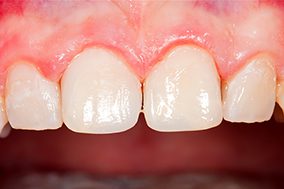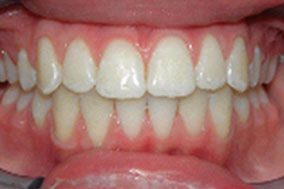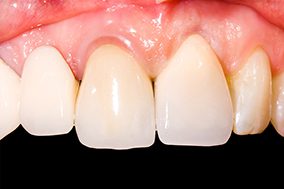Dental Conditions
Broken Teeth
Although the enamel covering your teeth is strong, it’s not totally invincible. A traumatic blow or crash can easily cause a tooth to break. Or something as normal as chewing on a pencil or even biting your fingernails can cause serious damage. Cavities or tooth erosion can weaken your teeth, making them more susceptible to breaking. A severe break can go deep enough that it exposes the nerve within the tooth, making it one of the most painful types of dental injury. A tooth that has a vertical split is likely to require a root canal treatment, especially if the tooth has only one root. The crack originates in the tooth root, then extends upward until it reaches the chewing surface of the tooth. In most cases, this results in inflammation and infection.
Before

After
Crooked Teeth
Most often crooked teeth, overbites, and underbites are inherited traits just as the color of your eyes or size of your hands. Other causes of misaligned bites are early loss of baby or adult teeth; improper fit of dental restorations (for example, fillings or crowns); gingivitis (gum disease); undue pressure on the teeth and gums; misalignment of the jaw after an injury; tumors of the mouth or jaw; or common oral health problems in children such as thumb sucking, tongue thrusting, pacifier use beyond the age of three, or prolonged use of a bottle. So, what kind of problems can crooked teeth cause, besides perhaps an unwillingness to smile? Unhealthy gums: Properly positioned teeth are easier to brush and floss than teeth that are crowded, crooked or spaced too far apart. More difficult cleanings: Crooked or misaligned teeth can increase the risk of plaque retention, tooth decay or periodontal (gum) disease. This can give way to cavities and gingivitis, as well. Abnormal wear of your jaw: A crooked set of teeth can put stress on your jaws and increase your chances of breaking a tooth.
Before

After
Missing Teeth
Did you know that the average adult between the ages of 20 and 64 has three or more decayed or missing teeth? If you are missing one or more teeth, call us at (707) 443-0210 to schedule your appointment. If a missing tooth is not addressed you could experience: Tooth Shifting: When you lose a tooth, the surrounding teeth begin drifting into the open gap, shifting your teeth out of alignment. What once was a straight smile can quickly turn into crooked teeth. If you see a dental implants dentist soon after you lose your tooth, you can replace your missing tooth before shifting occurs. TMJ Syndrome: When teeth shift out of alignment after tooth loss, bite problems usually develop. When the upper and lower jaws don’t meet properly, it strains and damages the jaw joint (TMJ). Gum Disease/Tooth Decay: Once teeth shift out of alignment, it is harder to reach some spots with your toothbrush or floss. When plaque and bacteria aren’t reached, tooth decay and periodontal disease develop, often causing further tooth loss.
Before

After
 (707) 433-0210
(707) 433-0210





